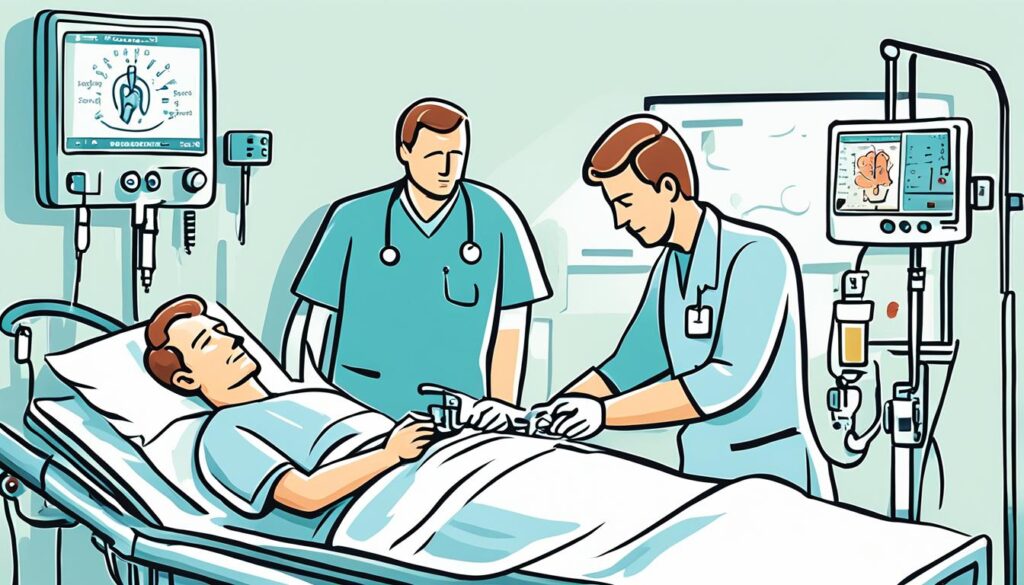Having an intestinal obstruction is serious. Getting quick and effective care is important to avoid bad issues. The treatment for intestinal obstruction often starts in the hospital. You might get an IV, a tube in your nose to reduce swelling, and a bladder catheter.
Table of Contents
ToggleThe management of intestinal obstruction changes based on why it happened and how bad it is. With partial blockages, doctors might first recommend a low-fiber diet or drugs. But, if the blockage doesn’t go away, surgery is usually needed to fix it, removing any bad parts of the intestine.
A special metal stent can sometimes be used to open the blockage temporarily. This is more common for colon cancer cases. It’s important to handle the situation right to stop problems like ischemia, necrosis, and perforation.
The main goal of intestinal obstruction treatment is to get things moving normally again. Your healthcare team will figure out the best plan for you. They’ll consider what’s going on with you and what you need.
Understanding Intestinal Obstruction
Definition and Classification
Bowel obstruction means food can’t move along the gut like it should. This can happen for different reasons. Sometimes, it’s because the bowel itself doesn’t work right, or something is physically blocking it. These blockages can happen in the small or large intestine. In the small intestine, the problem might be near the start or the end. It can be a complete block or only a partial one. Sometimes, the blockage causes more serious problems like the blood supply being cut off or the gut tearing.
Another way the bowel can get blocked is called intussusception. This happens when one part of the intestine gets sucked into another. A twist in the bowel is known as a volvulus. It’s rare, but sometimes a gallstone can block the bowel. This happens when a gallstone moves from the gallbladder and gets stuck in the gut.
Types of Intestinal Obstruction
Blockages in the bowel might be from something inside the gut, on the gut wall, or pressing on the outside. Sometimes, the gut muscles don’t work right, causing a blockage. This is often because the gut is not moving food along properly. Common things that cause blockages include scars from past surgeries, bulges in the gut wall (hernias), and tumors. Infections or twists in the gut can also block it. Intussusception can occur more often in kids. A growth, like a tumor, is often the cause in adults. A volvulus is mostly found in the colon but can also twist the small intestine. It often happens around areas like Meckel’s diverticulum. Gallstones causing a block is because the stone moves from the gallbladder and gets stuck in the gut.
Causes and Etiology
Many things can make the bowel not work right, including health conditions and certain drugs. A blockage can happen if there’s something blocking the inside, stuck to the wall, or pressing from outside. Intussusception is when one part of the gut slides into another. This is usually because of something like a growth or a bulge in the gut. A volvulus happens when the gut twists. This can happen around a special area in the gut called Meckel’s diverticulum. It can also twist when there’s a blockage and the gut folds over itself. A gallstone can move from the gallbladder and get stuck in the gut, causing a blockage.
Pathophysiology of Intestinal Obstruction
Acute small bowel obstruction is a serious condition. It causes big changes in the body. When the blockage is partial, the area right before it tries hard to push things through. But if the blockage is complete, nothing can go through. This causes a big build-up of fluid and strong movements trying backwards in the first stage of vomiting.
In some cases, the bowel movements just stop. This is called adynamic ileus. If that happens, the body can’t move food along like it should.
Changes in Intestinal Motility
When the bowel is blocked, its inside pressure goes up. This can cut off the blood flow. Without enough blood, parts of the bowel can’t get the oxygen they need. This leads to injuries like tissues tearing.
The blockage might be so strong that it cuts off blood flow completely. This causes part of the bowel to die. Sometimes, the pressure itself can hurt the bowel. This can happen if something like a large stone presses on it.
Intestinal Ischemia and Necrosis
When a blockage happens, the body starts losing too much water and salts. The colon can’t absorb things as it should. This leads to a lot of vomiting and a mess inside the stomach.
The body then starts to leak water and salts into the stomach area. This makes things worse by adding too much fluid. There can also be problems with losing too much salt or minerals.
Fluid and Electrolyte Imbalances
Before the blockage, the bowels have their own good bacteria. But when the bowel can’t move, bad types of bacteria can grow. This can make a very toxic liquid.
This toxic liquid can get into the blood and cause serious infections. The body can get very sick.
Bacterial Overgrowth
Intestinal obstruction can lead to many dangerous changes in the body. Changes in how the muscles work, lack of blood flow, and bad bacteria growing are just some problems.
It’s key to know about all these issues to treat them correctly. Not doing so can lead to very serious conditions. These include the bowel tearing, parts of it dying, and the body getting a harmful infection.
Diagnosis of Intestinal Obstruction
To find out if you have an intestinal obstruction, doctors look at how you feel and use certain tests. The main signs of a blockage are pain, throwing up, not being able to go to the bathroom, and a swollen belly.
Clinical Presentation
The way you feel and your symptoms can show if the blockage is in a small or large part of your intestine. Small bowel problems often lead to sharp pain, lots of throwing up, and a big belly. But, if the large bowel is blocked, you might find it hard to go to the bathroom, have different poo, and feel less pain and throw up less.
How you throw up can tell the doctor where the blockage is. If it’s high in the small bowel, you might throw up green or yellow stuff. But if the block is low in the small or large intestine, your vomit could smell bad.
Imaging Studies
Doctors usually start with a simple belly X-ray. This X-ray finds a blockage correctly in about 50-60% of the time. Sometimes, they need a CT scan, a more detailed X-ray, to get more information.
Differentiating Simple and Complicated Obstruction
It’s very important to know if the blockage is simple or complicated. A simple one means there’s a block but no dead tissue. A complicated blockage has signs of a more serious issue, like bad blood flow or dead tissue.
It can be hard to see the difference without a CT scan. This detailed X-ray can show if there’s a bigger problem with the blood flow or damage to the tissue.
Initial Management and Stabilization
When you have intestinal obstruction, the first goal is to make you stable. This often means getting an IV line to help with fluids. The aim is to fix any water loss or imbalance in your body’s minerals. These problems can be from the blockage and throwing up or not absorbing enough fluids.
Intravenous Fluid Resuscitation
It’s very important to get the right fluids into your body early on with intestinal obstruction. This step can help you get back to a good fluid level. It also takes care of any changes in your body’s minerals from the blockage and throwing up.
Nasogastric Tube Decompression
Doctors might put in a nasogastric (NG) tube to help empty the bowel and reduce swelling. The tube takes out gas and liquid from the stomach. It’s called decompression and it can help you feel better. But not every doctor agrees if the NG tube is always needed when the small bowel is blocked.
Monitoring for Complications
If you have intestinal obstruction, you need to be watched closely for issues like bowel blockage or tears, and mineral imbalances. Doctors will check your heart rate, your belly, and do lab tests a lot. If your heart is beating fast, you have sharp belly pain, high white blood cell counts, or a fever, it could mean big trouble. You might need surgery right away.

Non-Operative Management
For patients with partial intestinal obstruction, some fluids and air might still get through the blockage. In such cases, doctors might not choose surgery right away. Instead, they go for non-operative care. This plan includes not eating, getting fluids, and eating a special diet that’s easy on the stomach. If this method doesn’t work, surgery could be the next step.
Conservative Treatment for Partial Obstruction
Doctors find that many obstructions caused by adhesions get better without surgery. So, they often start with non-surgical treatment. This means letting the stomach rest, giving lots of fluids, and eating a specific low – fiber diet. This helps move stomach contents through without more blockage.
Role of Water-Soluble Contrast Agents
Water-soluble contrast agents, like Gastrografin, have special uses in treating adhesion blockages. They help figure out if the blockage is severe or not. Sometimes, they can even help the blockage go away by pulling in more fluid. But, not everyone agrees on using them. There’s still a chance of getting these liquids into the lungs or hurting the stomach more.

Intestinal Obstruction Treatment
For people with a full intestinal blockage, surgery is often needed. The kind of surgery depends on what’s causing the problem and where it is. Doctors might remove the blockage or use a metal stent. This stent helps clear the path for things trying to pass through.
Surgical Options for Complete Obstruction
Sometimes, they perform surgery called bowel resection and anastomosis. This means cutting out the blocked or damaged part of the bowel and then joining the healthy ends together. The goal is to make the path open again.
The doctors decide how much to remove and how to reconnect based on what they find during surgery.
Bowel Resection and Anastomosis
For those who can’t have surgery right away, like patients with colon cancer, they might use a stent first. This stent is put in place with a small scope. It helps widen the blockage so things can move through easier. But, most patients will still need surgery later on.
Stenting for Obstructing Lesions

Management of Specific Causes
While all intestinal obstructions share some solutions, special cases need unique treatments. Today, we’re focusing on intussusception, gallstone ileus, and volvulus.
Intussusception Reduction
Intussusception is when a part of the bowel folds into itself. In kids, doctors can try to push the bowel back with a barium or air enema. If this works, more action might not be needed. However, grown-ups often need surgery because of a tumor causing the problem.
Gallstone Ileus Treatment
Gallstone ileus comes from a gallstone blocking the bowel. The usual fix is surgery to take out the stone and maybe a bit of the bowel. Some people might have the stone out first, then the surgery later, especially if surgery poses a big risk.
Volvulus Derotation
Volvulus happens when the stomach twists, causing a blockage. Doctors might first try to untwist the colon with a scope. If this doesn’t work, or if it’s the small bowel, surgery is needed. During surgery, the bowel is also anchored to stop it from twisting again.

Postoperative Care and Monitoring
After surgery for an intestinal obstruction, managing fluids and electrolytes is key. Obstructions, vomiting, and fluid shifts can cause imbalances. It’s vital to watch over the patient’s vitals and lab results. This lets the medical team adjust fluids, electrolytes, and correct the acid-base balance as needed.
Nasogastric Tube Management
The use of a nasogastric tube after surgery is debatable. While some research says it’s not always needed, it can help with issues like bloating or stopping the patient from breathing in stomach contents. Doctors decide whether to keep or remove it based on how the patient is doing.
Prevention of Recurrence
In post-surgery care, avoiding another intestinal obstruction is crucial. The medical team works to stop the obstruction’s main cause. This might mean using special barriers or new surgery methods. They also teach patients what to eat and how to live to lower the chance of it happening again. Eating more fiber and staying at a good weight are part of this advice.
Complications and Management
Intestinal obstruction is a serious issue. It can cause problems like bowel ischemia, perforation, and lead to sepsis and peritonitis.
Bowel Ischemia and Perforation
When the bowel faces high pressure, its blood flow may decrease. This leads to tissue death and even holes. It’s critical to spot this early and treat it with surgery. Signs like a fast heartbeat, pain in one spot, or belly tenderness are key to notice.
Sepsis and Peritonitis
If not treated promptly, intestinal blockage can also push the body into sepsis or peritonitis. These are serious infections. Watch closely for fever and other signs of infection. Quick action with antibiotics and surgery could be life-saving.
FAQ
What is the general treatment approach for intestinal obstruction?
The first step in treating intestinal obstruction is hospitalization. It aims to make the patient stable. This involves several steps. It might include placing an IV line and a nasogastric tube.
Doctors also place a catheter in the bladder. The exact treatment varies based on what caused the obstruction and how bad it is.
What are the different types of intestinal obstruction?
There are two main types: functional and mechanical. Mechanical obstructions can happen in the small or large bowel. They may be high or low, closed loop or not, and more.
What are some common causes of intestinal obstruction?
Blockages in the small bowel can happen because of many reasons. It could be from something inside the bowel, like a tumor, or from outside, like a hernia. Other things, like diseases or certain drugs, can also cause blockages.
How does intestinal obstruction affect the body’s physiology?
When the small bowel is blocked, it causes big changes in the body. This includes more pressure inside the bowel and less blood flow. It can also lead to problems with fluids and bacteria growing more than usual.
What are the key diagnostic tools for intestinal obstruction?
Doctors use a few tests to diagnose bowel obstruction. They start with how the patient feels and an X-ray. Then, they might use other tests like CT scans or an ultrasound to learn more.
How is a partial intestinal obstruction managed?
If only a part of the bowel is blocked, surgery might not be needed right away. Patients might need to rest their intestines for a while. They’ll also get fluids and a special diet.
If the blockage doesn’t get better with time, surgery could still be needed.
What are the surgical options for complete intestinal obstruction?
A full blockage usually means surgery is needed. The goal is to remove the blockage. Sometimes, doctors connect the healthy parts of the intestine back together. Or they might use a stent to keep the area open for a bit.
How are specific types of intestinal obstruction managed?
For special cases like intussusception, doctors can sometimes fix it without surgery. For others, like gallstone ileus, surgery is often the best choice.
What are the key considerations in the postoperative care of patients with intestinal obstruction?
After surgery, it’s important to carefully manage fluids and electrolytes. Doctors might or might not use a nasogastric tube. They also focus on solving the issue that caused the blockage to stop it from happening again.
What are the serious complications of intestinal obstruction?
If not treated quickly, intestinal blockages can be very dangerous. They could cause the bowel to burst, leading to serious infection. Surgery is usually needed to fix these problems.
Source Links
- https://www.mayoclinic.org/diseases-conditions/intestinal-obstruction/diagnosis-treatment/drc-20351465
- https://www.mayoclinic.org/diseases-conditions/intestinal-obstruction/symptoms-causes/syc-20351460
- https://www.ncbi.nlm.nih.gov/pmc/articles/PMC10040372/
- https://www.hopkinsmedicine.org/health/conditions-and-diseases/understanding-an-intestinal-obstruction
- https://www.ncbi.nlm.nih.gov/books/NBK441975/
- https://www.aafp.org/pubs/afp/issues/2011/0115/p159.html
- https://www.ncbi.nlm.nih.gov/pmc/articles/PMC4786496/
- https://www.ncbi.nlm.nih.gov/books/NBK572336/
- https://emedicine.medscape.com/article/189146-treatment
- https://www.uptodate.com/contents/management-of-small-bowel-obstruction-in-adults
- https://www.webmd.com/digestive-disorders/what-is-bowel-obstruction
- https://www.mountsinai.org/health-library/diseases-conditions/intestinal-obstruction
About The Author

This article is medically reviewed by Dr. Nivedita Pandey, Senior Gastroenterologist and Hepatologist, ensuring accurate and reliable health information.
Dr. Nivedita Pandey is a U.S.-trained gastroenterologist specializing in pre and post-liver transplant care, as well as managing chronic gastrointestinal disorders. Known for her compassionate and patient-centered approach, Dr. Pandey is dedicated to delivering the highest quality of care to each patient.
→ Book a consultation to discover which remedies suit your needs best.
About Author | Instagram | Linkedin





